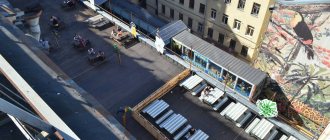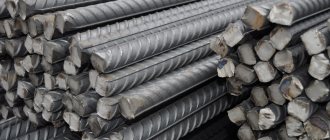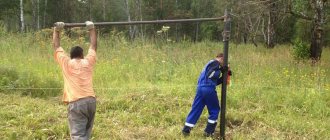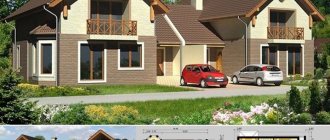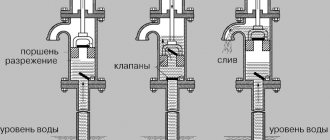Why did I decide to build a house
I spent 20 years of my life in my parents’ house in the Leningrad region and simply could not imagine myself in an apartment. Therefore, when the time came to get my own home, I decided to build a house.
At first I planned to build a house on the seashore: I bought a plot of land in Yevpatoria, where I wanted to move for permanent residence, and started saving for the box of a house. But the plans were not destined to come true: the parents’ house burned down, and there was nowhere to live. Then I couldn’t think of anything better than to sell a plot by the sea for 1,200,000 rubles and build a house in my homeland - in the city of Novaya Ladoga, Leningrad region.
How to choose land
I looked at several dozen sites. The main criteria were:
- hospital, school, shops and other social facilities are within walking distance;
- communications connected to the site or the ability to connect them;
- availability of roads and access roads for construction trucks;
- acceptable soils, at least fine sand - did not consider areas on clay or peat;
- unflooded area;
- developed site - without garbage, weeds, trees for cutting down: I wanted to start construction as quickly as possible so as not to spend extra money on renting an apartment.
The cost of plots for individual housing construction within the city in Novaya Ladoga starts from 1,000,000 rubles. But in a gardening non-profit partnership (SNT) you could buy six acres for 150,000 rubles. As a result, I bought land in SNT for 250,000 rubles. As a bonus I received a change house on the site - an old house. Immediately after purchasing the land, he began building a house.
Instructions: how to choose a country house or dacha and buy it with a mortgage
Read on topic
Moving schedule for renovation in Moscow
So, the renovation will take place in three stages:
- 2020-2024: resettlement of almost 200 thousand people from 930 old houses;
- 2025-2028: second wave, more than 1,500 houses to be demolished and more than 300,000 people;
- finally, almost 400 thousand more residents of the capital from 1,800 houses will move from 2029 to 2032.
Some houses were left without specific time periods. Decisions on them will be made in accordance with the approval of urban planning documents. The approximate publication date is scheduled for the 1st quarter of 2022.
How did you plan the construction?
There was very little money, but I didn’t want to skimp on the quality of materials. Therefore, I decided to build a small one-story house with an area of 50 square meters with a layout in the style of a Euro-bedroom: one room is separate, and the second is combined with a kitchen.
By one of my degrees I am an industrial and civil construction engineer. I decided to do the house project myself. As it turned out later, this was a big mistake. A home design is more than just a floor plan. This is a detailed instruction for construction: architectural section, structural section, work design and many more sections. The project is worth the money, there is no need to save on this. Then spend more time thinking about what to do, how to do it, and how much to buy.
I took the Polish Z7 series house project as a basis, “threw out” two rooms from it and got the required size of 50 square meters.
What else changed in the project:
- instead of a panoramic window I made a regular one;
- made the bathroom separate;
- I increased the length of the house a little so that it became symmetrical - in the original design, the entrance to the house was not in the center;
- I removed the vestibule and storage room and “teared down” the partitions.
The main set of drawings was made in AutoCAD (computer-aided design program - editor's note). Kind people made a 3D design of the house for me already at the stage of completing the roof.
House according to the original project Z7. Photo: z500proekty.ru.
House according to the original project Z7. Photo: z500proekty.ru.
House according to my design.
House according to my design.
How I failed communications
The first thing I did after purchasing the plot was submit an application for electricity connection to the local network organization Lenenergo. Electricity was connected within five months. It cost 8000 ₽.
To bring water to the site, I paid 70,000 rubles: 43,000 rubles for permission from SNT to connect to the city water supply and 27,000 rubles for the work on connecting and supplying it to the site.
I made the sewerage system from drainage filtration wells and spent 40,000 rubles. If I were buying a local treatment facility, I would pay 120,000 rubles. Saved 80,000 ₽.
House demolition schedule - addresses of buildings by Moscow districts
Basmanny district
- Bakuninskaya st., vl. 60
- Poslannikov lane, ow. 18-Starokirochny lane, ow. 5
- Krasnoselsky quarter 998, 2/1, building 1,2
- Rusakovskaya st., 6
- Tagansky st. Melnikova, 2
SAO
- Beskudnikovsky district, apt. 8, 9, building 1, 2
- Voykovsky district, Narvskaya st., ow. 5
- Golovinsky district, Avangardnaya st., ow. 10, Flotskaya st., vl. 68, buildings 1 and 2, Onezhskaya st., ow. 35, building 5, 6 and 7, Kronstadt Boulevard, ow. 55, Smolnaya st., ow. 21
- Western Degunino district, Angarskaya st., no. 33, Bazovskaya st., no. 15, st. Taldomskaya, vl.1
- District Koptevo, 3rd Novomikhailovsky Ave., ow. 8, building 1
- Timiryazevsky district, Astradamskaya st., vl. 9A, Dmitrovskoe highway, ow. 55
NEAD
- Alekseevsky district, st. Staroalekseevskaya, ow. 3
- Butyrsky district, microdistrict. 78, room 66, st. Rustaveli, vl. 3, room 4
- Losinoostrovsky district, st. Izumrudnaya, ow. 26A, microdistrict 3, room 53, st. Taininskaya, ow. 13
- District Marfino, Gostinichny pr., vl.8, bldg. 2
- District Maryina Roshcha, st. Oktyabrskaya, vl. 1058, Sheremetyevskaya st., vl. 5, k.1, 13, k.1
- Rostokino district, st. Agricultural, building 14
- Sviblovo district, Nansen passage, ow. 8
- District Yuzhnoye Medvedkovo, st. Molodtsova, 33, building 1
- District Yuzhnoye Medvedkovo, Dezhneva proezd, 12, building 1
VAO
- Bogorodskoye Millionnaya st., vl. 3
- Bogorodskoye district, microdistrict. 8B, room 4
- District Vostochnoye Izmailovo, 13th Parkovaya St., ow. 16, 15th Parkovaya st., ow. 27, 16th Parkovaya st., ow. 12
- Golyanovo Shchelkovskoe highway, 71, building 1 and 73
- Ivanovskoe district, microdistrict. 40-52, rooms 2 and 5
- Izmailovsky Ave., ow. 5
- Kosino-Ukhtomsky district, st. Black Lake, ow. 2-8, Orenburgskaya st., no. 3, Kaskadnaya st., ow. 21, plot 1 and 2
- Metrogorodok district, Otkrytoe highway, ow. 30, 26
- Perovo district, Plekhanova st., ow. 18, 22, 2nd Vladimirskaya st., ow. 30, Zeleny prospect, ow. 27-29
- Northern Izmailovo district, microdistrict. 80, bldg. 7 and 9, Konstantin Fedina st., ow. 13-19
How I build a house, how much money and what I have already spent on
I do the construction work myself, and my friends also help. Thanks to this I save money.
Foundation — 250,000 ₽
As a foundation, I made an almost insulated Swedish stove: instead of a water-heated floor, I made an electric one in a screed, since there is no gas on my site.
If gas heating is assumed, it is rational to make a water heated floor. When there is no gas, there is no need to heat water with electricity or heat the floor with water. It is better to immediately heat the floor with electricity.
Foundation slab before pouring concrete.
Walls — 250,000 ₽
I chose gas block for the walls. This solution was suitable for heating engineering in our region, and the walls did not have to be additionally insulated, which, again, is a saving.
Walls made of gas block.
Suspended construction
When it came time to do the overlap, difficulties began. I planned to make the ceiling from laminated veneer lumber, but they practically cheated me with the timber: I placed an order, waited a month, but the order was never completed. In addition, I was robbed - all the tools were taken out of the change house.
All this slowed down the construction, and I didn’t have time to finish the roof before winter. Therefore, I decided to freeze construction until next spring.
Over the winter, I revised the concept of the house. I decided to add an attic floor and build a house not of 50 square meters with one separate room, but of 80 square meters with three separate rooms. I plan to use the attic floor as an office, home theater, exercise room, and possibly a playroom for children in the future.
He resumed work in the spring.
Floors and ceiling - 120,000 ₽
For the ceiling I chose laminated veneer lumber. I paid 73,000 rubles for 11 beams.
47,000 ₽ were spent on the ceiling of the first floor, filling between the beams for sound insulation and the subfloor in the attic. Of course, it was possible to use ready-made reinforced concrete slabs. They are cheaper, but delivery to my city would be golden. In addition, the slabs have standard sizes, which did not suit my project.
Another option is a wooden floor made of planks. This is a cheap option, but such a ceiling has low noise insulation: stomping and creaking on the second floor will be heard below.
Floors between the first and second floors
Roof — 200,000 ₽
A big expense item for the roof is the purchase of metal tiles: 130 m² for 66,000 ₽. We also needed boards of different sizes - 70,000 ₽, planks - 16,000 ₽, drainage - 15,000 ₽, membrane - 10,000 ₽. The screws and nails alone cost more than 10,000 rubles.
I did the roof together with friends. If I had ordered a team, laying metal tiles would have cost 70,000 rubles. And the work there is for three days. My friends and I successfully did everything ourselves.
Windows and front door - 200,000 ₽
I ordered the windows for 160,000 rubles - this was practically the most budget option. But still, the price turned out to be rather high: the house has five windows, one of them is a floor-length panoramic one with access to the terrace. This alone cost 70,000 rubles. In addition, window prices have increased by 40% this season.
I ordered the door for 40,000 rubles. Because the door to the house needs a special weather-resistant coating and a thermal break. Such doors are several times more expensive than apartment doors.
Tools — 75,000 ₽
Another big expense to consider when planning your home in your overall budget. The most expensive ones were a laser level, an angle grinder and a circular saw; I paid 20,000 rubles for them.
1958 March 2 Enlisted in the lists of Navy ships;
1958 The main crew was formed. The crew was trained and became part of the 150th DnOPL of the 339th BrSRPL BelVFl;
1958 June 15 Laid down in the workshop of Shipyard No. 402 in Severodvinsk as a CRPL;
1961 The 246th reserve crew was formed;
1962 April 1 Launched (taken out of dock). It was part of the 339th BrSRPL BelVFl of the Northern Fleet;
1962 May 8 - June 10 Mooring tests;
1963 January 10 - February 22 Complex mooring tests of the power plant were carried out under the leadership of the energy section of the Government Commission;
1963 June 22 - 26 Factory tests;
1963 June 29 - October 30 State tests;
1963 On October 30, the State Commission signed an act on the completion of state tests. Came into operation. Beginning of trial operation. It was part of the 14th BrPL of the Yokanga naval base of the Northern Fleet, based at Gremikha Bay;
1964 April 21 - June 12 Made the 1st autonomous cruise to the BS (commander - Capt. 1st Gulyaev I.I., senior - V.A.L Kholostyakov G.N.) lasting 52 days in the Central Atlantic region. The nuclear submarine went on a 40-day autonomous voyage, during which the crew, including the leader of the voyage, Vice Admiral G.N. Kholostyakov, who were on board. and representatives of naval departments, appealed to the command to extend the voyage period to 50 days. Having reached the territory of equatorial waters on May 17, 1964, the crew of the nuclear submarine conducted 2-week intense tests of the ship's equipment, and in particular the nuclear reactor at medium and full speed, which were successful. For the first time in the history of the Russian submarine fleet, records were set for continuous diving at distances of 1000 miles, 5000 miles, 10,000 miles and beyond! On June 12, 1964, she carried out excellent torpedo firing, setting a diving record - over 50 days without surfacing. During 1240 running hours, the submarine covered 12,425 miles (12,278 miles under water). For the successful completion of tasks in the first autonomous cruise, the commander of the submarine Gulyaev I.I. awarded the title of Hero of the Soviet Union;
1965 June Completed the tasks of the combat training course (commander - cap. 2nd r. Leonov P.F., senior - NSh 11th DiPL cap. 1st r. Mikhailovsky A.P.) and transferred to Zapadnaya Litsa;
1965 July 16 - September 13 Made the 2nd autonomous campaign to the BS (commander - cap. 2nd r. Leonov P.F., senior - NSh 11th DiPL cap. 1st r. Mikhailovsky A.P.) lasting 60 days in the Mediterranean sea. Returned to Zapadnaya Litsa. The hike covered approximately 15,000 miles. Two days after returning from the campaign, the nuclear submarine moved to its permanent base - Gremikha;
1965 September 7 Became part of the Red Banner Northern Fleet, included in the 14th BrPL (from 04.1966 - 17th DiPL) of the Yokang naval base of the KSF, based at Gremikha Bay. Classified as a subclass of experimental CRPL;
1965 October (presumably) Moved to Severodvinsk to the Sevmashpredpriyatie PA to carry out inter-trip repairs and recharge of reactors;
1967 January - February Reactors were recharged;
1967 October Moved from Severodvinsk to Gremikha;
1967 October 13 While at sea, an alloy was thrown into the gas system of the 1st circuit of the starboard reactor. Its cause was slag deposits (oxides of the lead-bismuth alloy), which blocked the passage for the coolant, which began to flow into the gas system. As a result of this accident, two pumps were filled with frozen alloy. We had to disable the starboard PPU, interrupt the trip and return back to base. The reasons for this leak remained unknown, as well as who exactly was to blame;
1968 May 21 Went to sea to practice combat training tasks and test nuclear power plants (commander - Capt. 1st Rank Leonov P.F.). There were 147 people on board. Almost entirely the first crew, and a significant part of the sailors from the second crew, this is 39 people. The entire team of special hold crews, KGDU officers and control officers, as well as other specialists. The command of the second crew also went to sea, commander Novitsky G., first mate Tomko E., assistant commander of the ship Salnikov L.;
1968 May 24 While checking the parameters of the power plant at full speed in a submerged position, the AR-1 automatic control rod spontaneously reached the upper limit switch, and the power of the LB reactor began to decrease rapidly in 60-90 seconds. fell from 83 to 7%. The accident was accompanied by a sharp increase in gamma activity in the reactor compartment (up to 150 r/h and above), the release of radioactive gas from the gas system into the reactor compartment with its subsequent spread to other compartments. All crew members (124 people) were overexposed. The KrPL surfaced and the transition from the test site to the base was carried out while the PB reactor was operating. The submarine was placed at the pier in Gremikha Bay. The SKR "Bars" (project 50) was moored to the submarine, through the TCP of which a steam pipeline was transferred to the submarine. At the SKR, the Aquarius supplied high-frequency air from the coastal station; the main boilers of the SKR supplied high-frequency air to the boat circuit so that the metal coolant did not cool down. In total, during the accident and immediately after it, 4 submariners died in the hospital (Petrov A., Gritsenko V., Voevoda V. and Kulikov V.). Ponomarenko I. later died while keeping watch on the ship. For the period 1968-2003. over thirty sailors who took part in the liquidation of the accident passed away;
1968 June 20 The necessary operations to cool the PUF and freeze the alloy were completed. All submarine mechanisms were taken out of action and mothballed;
1969 - 1970 The 246th crew was reorganized into the 426th crew. Confusion is possible and the crew could originally have been 426;
1968 - 1973 She was laid up in Gremikha Bay. Until 1973, various experimental work was carried out at KrPL. The possibility of using a nuclear submarine with one restored reactor on the starboard side, the option of cutting out the emergency compartment and replacing the liquid metal PPU with water-cooled units of the VM-A type were studied;
1974 By this time it was based in Severodvinsk. Presumably part of the 299th ODnPL BelVMB;
1979 February 1 Expelled from the Navy;
1980 October 1 Crew disbanded;
1981 May Docked at the Zvezdochka Shipyard (Severodvinsk). The cavities of the PPU equipment and its pipelines were filled with a special composition, which, after hardening, prevented the washing out and release of radioactive materials from the reactor. The free volumes of the compartment and the water-lead protection tank were filled with bitumen. In total, about 270 tons of bitumen were poured into the compartment, which completely closed the reactors. This achieved complete exclusion of water from reaching contaminated equipment and subsequent contamination of the environment in the area where the nuclear submarine was sunk. The mothballing of the reactor compartment made it possible to bring the levels of penetrating radiation on the surface of the light body to background values;
1982 September Towed to a specially designated landfill (72 degrees 31'N 55 degrees 30'E) of the Kara Sea off the north-eastern coast of the Novaya Zemlya archipelago in Stepovoy Bay and sunk at a depth of 33 m;
2011 Information appeared in the media that the lifting and dismantling of the K-27 is planned for 2014. The head of the North-West Center for Radioactive Waste Management (SevRAO) Valery Panteleev spoke about this in an interview with RIA Novosti;
2011 An interdepartmental seminar “Review of scientific and technical problems and the search for their solutions during the recovery and further handling of the K-27 nuclear submarine” was held. A plan of further actions for the period 2015-2020 has been determined;
2015 Presentation “Problems of ensuring environmental safety of Arctic waters, islands and coastal areas” was held. The further action plan for the period 2016-2022 has been adjusted;
2015 Development of technical projects USP project 23570 and GPU-6000/300 and a preliminary design of load-handling devices for lifting the nuclear submarine K-27 . By 2016, it was planned to identify a builder plant, develop a design documentation for the USP in the scope of “ship in construction”, lay down the USP of project 23570 in the 4th quarter of 2016, carry out the KIRO nuclear submarine K-27 ; by 2017 - preparation for the lifting of the K-27 , construction of USP project 23570; by 2022 - testing and delivery of project 23570 USP, lifting of the K-27 ; by 2022 - transfer of the nuclear submarine K-27 to the Gremikha branch of OJSC SevRAO; by 2022 - unloading of spent nuclear fuel (SNF) and dismantling of nuclear submarines. However, the plans were never implemented;
2020 August 3 The Rosatom State Corporation expects to raise six of the most radiation-hazardous objects from the bottom of the waters of the Arctic zone of the Russian Federation in eight years - sunken parts of an icebreaker, nuclear submarines K-27 and K-159 , reactors with spent nuclear fuel;
2021 March The Rosatom State Corporation announced a tender, which refers to work on preparation for disassembly and the actual disassembly of spent removable parts (SRF) of a decommissioned nuclear submarine (NPS) of Project 645 (“product 64”) in Gremikha, Murmansk region. Also, cassettes with irradiated VHF fuel assemblies will be prepared for transportation for reprocessing and containers with spent nuclear fuel will be delivered to the storage site of the federal state unitary enterprise of the nuclear fleet. The starting price of the tender is about 500 million rubles. Anatoly Grigoriev, head of international technical assistance projects at the Rosatom State Corporation, explained that we are talking about the removable parts of the K-27 , which were reloaded in 1967. After unloading, the cores were placed for storage at Gremikha. Various options, technologies and methods for creating a vessel for lifting flooded and sunken objects are currently being studied. Subsea research, design and construction of the recovery vessel is expected to continue until the end of 2026. The lifting of the K-27 , along with design and dismantlement, will take four years, approximately from 2028 to 2031.
What other costs are coming?
As of today, I have spent, together with the purchase of the site, tools, communications, walls and roof without insulation, approximately 1,500,000 rubles. And this is not all the costs. To move into, albeit into an unfinished house, you need about 1 million more rubles: they will have to insulate the roof, install plumbing and electrics, lay heated floors, do the interior decoration, equip the kitchen and bathroom.
Some sad news is that prices for building materials will almost double in 2022, and for some items – threefold. Because of this, my expenses increased significantly, and I did not meet the 1 million rubles as originally planned.
Implementation of the renovation program in Moscow
The project started in August 2017. As part of the program, it is planned to demolish 5,175 houses by 2032. It covers about 1 million people.
The program is aimed at objects of the “first wave” of industrial housing construction (1950-1960). It applies to five-story buildings in the following series:
- 1MG-300;
- K-7;
- 1605-AM;
- II-32 and II-35.
All of them are considered unsuitable for long-term use. Residents are provided with equivalent property in their home area. Construction is being carried out in stages. Initially, a house was erected where people were moved from the first building to be demolished. Then a second object appeared in its place for the next group, and so on.
At what stage is construction
Today I am at the stage of completing the warm circuit. I am pleased with the result of my labors. The house turns out to be pleasant in appearance, comfortable inside and embodying most of my wishes.
The condition of the house at the current stage of construction. I have already ordered the windows and door, I will install them as soon as they are ready.
Which houses will not be demolished?
A number of Moscow facilities will remain in place, even if they meet the program criteria. It is planned to preserve 218 buildings of cultural and historical value. The list includes houses on the streets:
- Rusanovskaya, 8, Bakuninskaya, 4-6 (TsAO);
- Dmitrovskoe highway, 125, 127 (SAO);
- Suvorovskaya, 6 (VAO);
- Derbenevskaya, 10 (Southern Administrative District).
Construction is currently underway at 164 sites. In total, the renovation program plans to put into operation more than 20 million square meters. m of housing.


